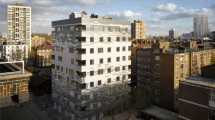Abstract
This paper describes the effects of fire on durability of reinforced concrete structures, and points out that fire not only damages the chemical composition and physical structure of concrete by high temperature, but also leads to an additional risk due to the generation of polyvinyl chloride (PVC) combustion gases. A mathematical model is proposed to calculate chloride ingress profiles in fire damaged concrete, so as to explore the service life prediction of the structure. Rapid Chloride Migration (RCM) test was carried out to determine the chloride diffusion coefficients for the application of the mathematical model. Finally, the detected results of a reported case testified to the validity of the mathematical model.
Similar content being viewed by others
References
Briesemann, D., Greger, H., 1970. Betonstein Zeitung, 5:314–321.
Chan, Y.N., Peng, G.F., Anson, M., 1999. Residual strength and pore structure of high-strength concrete and normal strength concrete after exposure to high temperatures. Cement and Concrete Composites, 21(1):23–27. [doi:10.1016/S0958-9465(98)00034-1]
Chan, Y.N., Luo, X., Sun, W., 2000. Compressive strength and pore structure of high-performance concrete after exposure to high temperature up to 800 °C. Cement and Concrete Research, 30(2):247–251. [doi:10.1016/S0008-8846(99)00240-9]
Chew, M.Y.L., 1993. The assessment of fire damaged concrete. Building and Environment, 28(1):97–102. [doi:10.1016/0360-1323(93)90010-Z]
Climent, M.A., Viqueira, E., de Vera, G., López, M.M., 1998. Chloride contamination of concrete by interaction with PVC combustion gases. Cement and Concrete Research, 28(2):209–219. [doi:10.1016/S0008-8846(97)00270-6]
Climent, M.A., de Vera, G., Lőpez, J.F., Viqueira, E., Andrade, C., 2002. A test method for measuring chloride diffusion coefficients through non-saturated concrete, Part I: The instantaneous plane source diffusion case. Cement and Concrete Research, 32(7):1113–1123. [doi:10.1016/S0008-8846(02)00750-0]
DuraCrete, 2000. Compliance Testing for Probabilistic Design Purposes. DuraCrete Final Report for the European Union Brite EuRam III, p.99–109.
Guo, X.F., Yang, X.L., Li, H.B., Chen, Y., 2000. Combustion characteristic of PVC. Journal of Fuel Chemistry and Technology, 28(1):67–70 (in Chinese).
Lay, S., Schießl, P., Cairns, J., 2003. Life Cycle Management of Concrete Infrastructures for Improved Sustainability. Technical Research Centre of Finland.
Luo, X., Sun, W., Chan, Y.N., 2000. Effect of heating and cooling regimes on residual strength and microstructure of normal strength and high-performance concrete. Cement and Concrete Research, 30(3):379–383. [doi:10.1016/S0008-8846(99)00264-1]
Martin, H., 1975. Betonwerk Fertigteil-Technik, 41:19–24.
Mirza, W.H., Al-Noury, S.I., Al-Bedawi, W.H., 1991. Temperature effect on strength of mortars and concrete containing blended cements. Cement and Concrete Composites, 13(3):197–202. [doi:10.1016/0958-9465(91)90020-1]
NT Build492, 1999. Chloride Migration Coefficient from Non-steady-state Migration Experiments. Nordtest Method.
Poon, C.S., Azhar, S., Anson, M., Wong, Y.L., 2001. Comparison of the strength and durability performance of normal-and high-strength pozzolanic concretes at elevated temperatures. Cement and Concrete Research, 31(9):1291–1300. [doi:10.1016/S0008-8846(01)00580-4]
Ulrich, S., 1986. Concrete at high temperatures. Fire Safety Journal, 13(1):55–68.
Yamada, Y., Oshiro, T., Masuda, Y., 1999. Study on Chloride Penetration into Concrete. Summaries of Technical Papers of Annual Meeting, AIJ, p.961–962.
Zhang, Y., 2005. Study on the Durability of Post-fire Concrete Structure. Master Thesis, Structural Engineering Institute of Zhejiang University (in Chinese).
Author information
Authors and Affiliations
Corresponding author
Additional information
Project (No. 50538070) supported by the National Natural Science Foundation of China
Rights and permissions
About this article
Cite this article
Jin, Wl., Zhang, Y. Fire’s effect on chloride ingress related durability of concrete structure. J. Zhejiang Univ. - Sci. A 8, 675–681 (2007). https://doi.org/10.1631/jzus.2007.A0675
Received:
Accepted:
Published:
Issue Date:
DOI: https://doi.org/10.1631/jzus.2007.A0675




